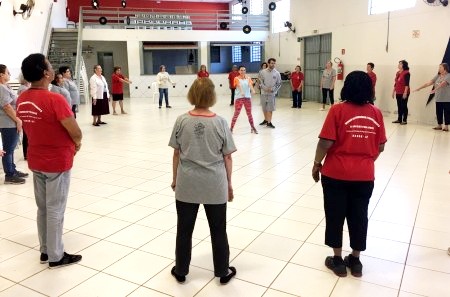

The study involved 92 socioeconomically vulnerable elderly women living in Bauru (photo: Emmanuel Ciolac/UNESP).
Researchers at São Paulo State University (UNESP) in Brazil evaluated the effect of three different low-cost training programs on a group of socially vulnerable female volunteers. HIIT combined with muscle strength exercises was the most efficacious in terms of reducing blood pressure and arterial stiffness, the main risk factors for cardiovascular disease.
Researchers at São Paulo State University (UNESP) in Brazil evaluated the effect of three different low-cost training programs on a group of socially vulnerable female volunteers. HIIT combined with muscle strength exercises was the most efficacious in terms of reducing blood pressure and arterial stiffness, the main risk factors for cardiovascular disease.

The study involved 92 socioeconomically vulnerable elderly women living in Bauru (photo: Emmanuel Ciolac/UNESP).
By Maria Fernanda Ziegler | Agência FAPESP – A study involving 92 socioeconomically vulnerable elderly women compared the efficacy of different low-cost community-based exercise programs to improve and/or maintain cardiovascular and functional parameters, such as waist circumference, blood pressure, and above all arterial stiffness, a risk factor for atherosclerosis.
An article describing the results is published in the European Journal of Preventive Cardiology. The main conclusion is that high-intensity interval training (HIIT) combined with resistance training (RT) to build muscle strength was the option most beneficial to the women’s health.
In HIIT, short periods of intense or explosive anaerobic exercise alternate with brief recovery periods. It involves whole-body exercises performed in the shortest time possible. It has been used for decades by high-performance athletes and has become a craze in recent years, mainly because sessions are short and no equipment is needed.
The other protocols tested were RT alone, and moderate-intensity aerobic training combined with RT. The study was conducted in Brazil with FAPESP’s support at São Paulo State University’s School of Sciences (FC-UNESP) in Bauru.
The volunteers performed the exercise programs twice a week for nine months at four neighborhood community centers run by an NGO. Clinical status, anthropometric measurements and specific health parameters (cardiovascular, functional, mobility etc.) were assessed before the first session (baseline), at the end of the nine-month intervention, and three months after that.
HIIT combined with RT and moderate-intensity aerobic training combined with RT were equally efficacious in terms of reducing waist circumference (by 3.3 cm on average). This benefit persisted after the end of the training period. However, only HIIT combined with RT effectively lowered systolic blood pressure (7.9 mmHg) and reduced arterial stiffness (0.69 m/s), which remained so three months after the end of the training period.
All three programs were efficacious in terms of improved functional performance (handgrip, flexibility, lower limb strength and mobility), but only HIIT combined with RT at least partially maintained the improvements after the intervention.
“The lack of improvement in cardiovascular parameters for the groups that performed RT alone or moderate-intensity aerobic training combined with RT suggests that HIIT was responsible for the improvement in blood pressure and arterial stiffness. The superiority of HIIT may have been due, at least to some extent, to the need for constant adjustment of blood vessels during interval training,” Emmanuel Ciolac, a professor at FC-UNESP and last author of the article, told Agência FAPESP.
During HIIT, heart rate and stroke volume (the volume of blood pumped out of the heart during each systolic contraction) increase, Ciolac explained. The rise is normally proportional to the intensity of the exercise. Arteries and smaller blood vessels expand to receive the augmented blood flow (vasodilation), contracting again while the body recovers and the blood flow decreases.
“Our hypothesis is that the primary mechanism behind the improvement in arterial stiffness is associated with this constant adjustment of blood vessels and the increase or decrease in production of vasodilatory substances during bursts of exercise alternating with recovery,” he said.
Public policy
The researchers believe that the findings of the study showing the benefits of an affordable exercise program will contribute significantly to the wellbeing of low-income older women, who are a high-risk group for cardiovascular diseases, and to the formulation of public policy relating to the prevention of those diseases.
“We expected HIIT combined with RT to assure more cardiovascular benefits, since for the last ten years we’ve conducted similar studies of other high-risk groups [people with obesity and diabetes, for example], and the combination has always proved beneficial to cardiovascular and metabolic parameters. What surprised us was that the improvement in arterial stiffness persisted even three months after the end of the training period. The training can be said to have slowed vascular aging in these women,” Ciolac said.
Arterial stiffness tends to increase the risk of cardiovascular disease. “A reduction of 7 mmHg in systolic pressure is very substantial and considerably lowers the risk of having a heart attack or stroke. Arterial stiffness is the main marker of vascular aging and a very important variable in abnormally high systolic pressure,” he explained.
Previous studies by his group showed that HIIT has no risks for people with high blood pressure, obesity or diabetes, or indeed for clinical populations in general. “The protocol requires a prior assessment to confirm the absence of contraindications, such as a high risk of heart attack, for example. Generally speaking, it’s very safe,” Ciolac stressed.
The article “Superior effect of long-term community-based high-intensity interval training on cardiovascular and functional parameters in low-income older women” is at: https://academic.oup.com/eurjpc/advance-article-abstract/doi/10.1093/eurjpc/zwae200/7691592?redirectedFrom=fulltext.
Republish
The Agency FAPESP licenses news via Creative Commons (CC-BY-NC-ND) so that they can be republished free of charge and in a simple way by other digital or printed vehicles. Agência FAPESP must be credited as the source of the content being republished and the name of the reporter (if any) must be attributed. Using the HMTL button below allows compliance with these rules, detailed in Digital Republishing Policy FAPESP.





